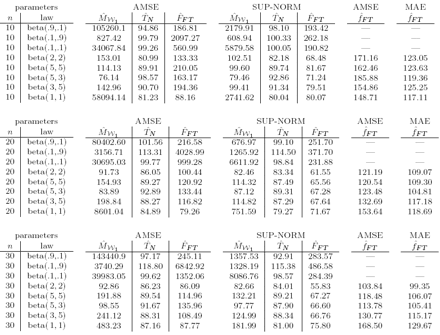Let T denote a random lifetime (or time until failure) with distribution function F. On the basis of a sample of n independent replications of T the object of inference are usually

Table 2: Relative efficiency of IFS-based estimator with respect to the empirical distribution function and the kernel density estimator. Small sample sizes.

Table 3: Relative efficiency of IFS-based estimator with respect to the empirical distribution function and the kernel density estimator. Moderate sample sizes. quantities derived from the so-called survival function S(t) = 1 − F(t) = P(T > t). If F has a density f then it is possible to define the hazard function
![]()
and in particular the cumulative hazard function
![]()
Usually T is thought to take values in [0,∞), but we can think to consider the estimation conditionally to the last sample failure, say τ and rescale the interval [0,τ] to [0, 1]. So we will assume, from now on, that all the failure times occur in [0,1], being 1 the instant of the last failure when the experiment stops. In this scheme of observation
![]()
is a natural estimator of S, with
![]()
any estimator of F and, in particular, the IFS estimator. A more realistic situation is when some censoring occurs, in the sense that, as time pass by, some of the initial n observations are removed at random times C not because of failure (or death) but for some other reasons. In this case, a simple distribution function estimator is obviously not good. Let us denote by
![]()
the observed instants of failure (or death). A well known estimator of S is the Kaplan-Meyer estimator

where r(ti) are the subject exposed to risk of death at time ti and di are the dead in the time interval [ti, ti+1) (see the original paper of Kaplan and Meyer, 1958, or for a modern account Fleming and Harrington, 1991). In our case di is always 1 as ti are the instants when failures occur. Subjects exposed to risk are those still present in the experiment and not yet dead or censored. This estimator has good properties whenever T and C are independent. Related to the quantities r(ti) and di it is also available the Nelson estimator for the function H
that is defined as
![]()
We assume for simplicity that there are no ties, in the sense that in each instant ti only one failure occurs. The function
![]()
is a increasing step-function. Now let
![]()
can be thought as an empirical estimates of a distribution function To derive and IFS estimator for the cumulative hazard function H we construct the sample quantiles by simply taking the inverse of
![]()
Suppose we want to deal with N +1 quantiles, being
![]()
and
![]()
One possible definition of the empirical quantile of order k/N is obtained by the formula
![]() (10)
(10)
for i = 0, 1, ...., d -1 and k = 1, 2,...,N-1 Now set pi = 1/N, = 1,2,...,N and
![]()
as in (10). An IFS estimator of H is
![]()
where
![]()
is the following IFS:

where
![]()
and u is any member of the space of distribution function on [0, 1]. In (10) we have assumed that
![]()
is the distribution function of a continuous random variable, with
![]()
varying linearly between ti and ti+1, but of course any other assumption than linearity can be made as well (for example an exponential behaviour). A Fleming-Harrington (or Altshuler) IFS-estimator of S is then
![]()
What is the gain in using our
![]()
instead of a standard Altshuler estimator. In principle, it is the same as in distribution function estimation: the Altshuler estimator is a function with jumps and this jumps are smaller with our IFS estimator. But one other important consequence could be the same. Suppose you want to estimate the function h. An estimator is usually given by a discrete density function that gives value di/ r(ti) on ti and zero elsewhere. The underlying distribution T is a continuous one so we can propose an estimator of its density f by means of the relation h(t) = f(t)/S(t). In fact, let
![]()
be the Fourier transform estimator of the density of
![]()
Then
![]()
is an estimator of h. A density estimator for f is then
![]()
or, in alternative, using the Kaplan-Meyer estimator of S
![]()
Stefano M. Iacus, Davide La Torre
Next: Final remarks
Summary: Index